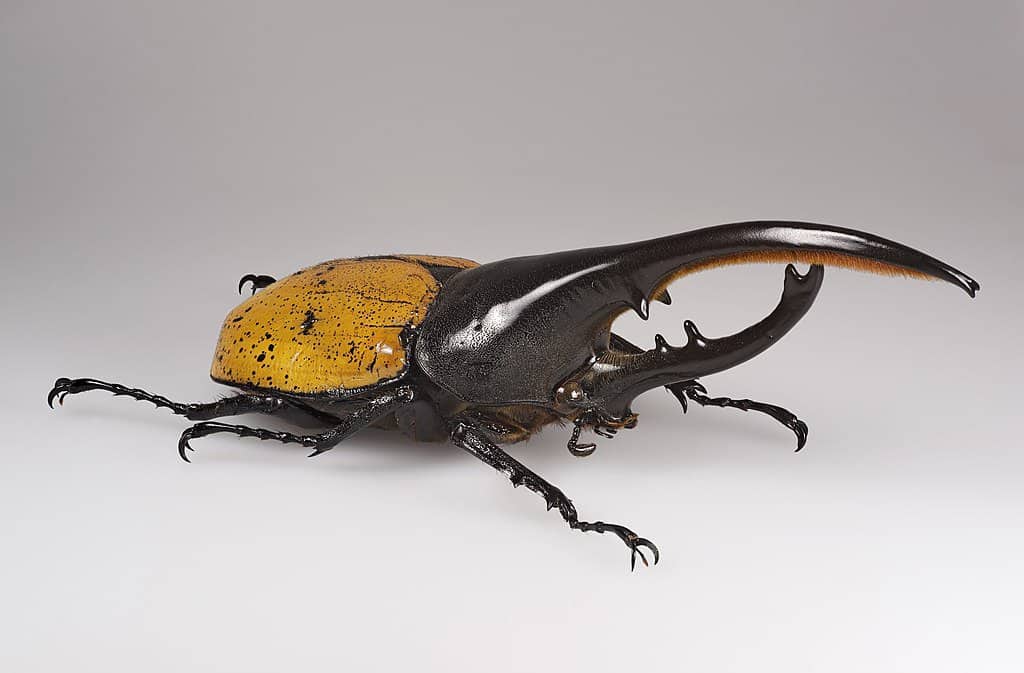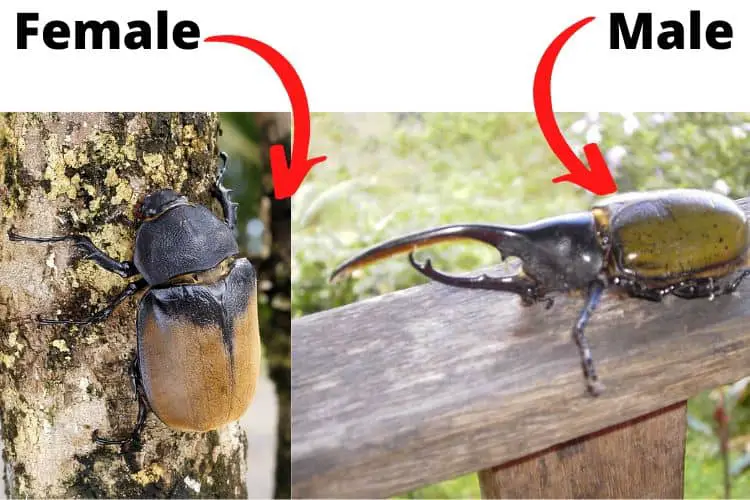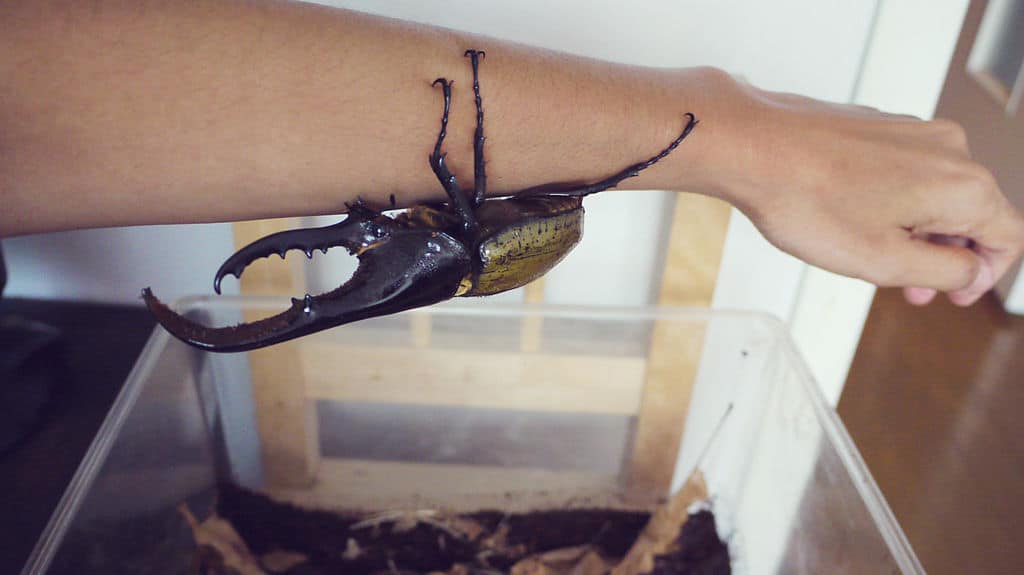The Hercules Beetle (Dynastes hercules) is the longest beetle in the world. With an incredible length of seven inches and an intimidating appearance, it bestows a powerful appearance that makes it an appealing pet. It’s also very strong, being able to exert up to thirty pounds of force, which means it’s as amazing as it looks.
If you’re interested in getting one of these powerful beetles, we’ve gathered all the information you need to know if it’s the best fit for you and how to properly care for them.

Hercules Beetle Care Sheet
| Name of species | Dynastes hercules |
| Family | Scarabaeidae |
| Common name | Hercules Beetle |
| Category | Beetle |
| Type | Rhinoceros Beetle |
| Native location | Central and South America. |
| Size | 7 inches |
| Weight | 5 ounces |
| Diet | Decaying wood, fruit |
| Lifespan | 2 to 3 years |
| Experience level | Beginner |
Hercules Beetle overview
The Dynastes hercules is known in the insect-keeping hobby as Hercules Beetle. This large insect is one of the biggest flying beetles in the world, but it spends most of its time burrowing. This amazing insect spends most of its life as a larva, being a stage that can last up to two years before it matures into an adult.
Found inside the bark of a tree or underground, you’ll see this beetle in the rainforests of South America, South America, and the Lesser Antilles. It’s a herbivore, feeding on rotting wood, sap, and fruit most of the time.
Appearance

The Hercules Beetle is known for having a long and strong horn coming out of the top of its head. It has a smaller and straight horn at the bottom, and it can move both horns closer to grab their rivals and throw them away.
They’re dark brown in color all over their body except for their elytra, which is yellowish-brown. Females look the same as males with the exception that they lack horns. This means the HB exhibits sexual dimorphism since males and females look different.
Price
Hercules Beetles are hard to come by since there are strong regulations around their import and export.
This raises the cost of an adult male to around $500, while in Japan they can even cost as much as $1000.
Grubs cost less and live longer, so it’s advisable to get several HB larvas if you have the chance.
Behavior and Temperament
Male Hercules Beetles are territorial and aggressive between them. If you make the mistake of placing two males in the same tank, they’ll fight each other and may even get hurt in the process.
Male HBs are also susceptible to sudden movements. They can get easily agitated, so be careful when you handle them.
In this same regard, make sure to place females in the enclosure gently (if ever) to keep the male from getting agitated; it is known that an aggressive or sudden approach may result in the male attacking and killing the female.
In spite of their violence toward each other, Hercules Beetles are actually peaceful and will allow you to handle them.
As long as you don’t get the HB agitated, you should be able to walk it down your hands without an issue. However, if you want to handle it, you should know its legs are fragile.
Don’t grab the beetle by its leg or force it out of a surface where it’s strongly attached or else you’ll risk injuring its legs.
These insects might look intimidating, but they do not pose a threat to humans. They do not bite and are not venomous or poisonous.
Caring for a Hercules Beetle

Temperature and Humidity
The Hercules Beetle is a nocturnal insect, so make sure its tank is away from the sunlight or it won’t be comfortable.
It lives in rainforest climates, where the climate is characterized by high humidity and temperatures. To keep your HB comfortable and make it feel at home, make sure the temperature ranges from 65°F to 75°F. The humidity should also be high, with 70% to 80% recommended for larvae and 60% to 70% for adults.
Substrate
The Hercules Beetle spends plenty of time burrowing during all of its development stages. It’s important that the substrate adapts to its needs. You should provide it with at least three to four inches of substrate to be sure it has enough room.
As for the composition, adults thrive in mixtures with coconut fiber for their moisture retention. Larvae, however, are happy with moist flake soil as it provides good structural support, as well as their food.
Tank
The longest beetle in the world needs enough room to move around. Males must be kept in separate enclosures or else they’ll fight for the territory. They also need enough space or else you risk them breaking their horns against the tank’s walls, so a tank of at least five gallons will work wonders for them.
The tank should be made of a strong material with good ventilation and a safety lid. These strong insects can break free if you give them the chance, so the enclosure must be fit to hold them safely.
Regarding decoration, your Hercules Beetle requires branches and bark to climb during the night. If by accident they fall upside-down, they’ll need strong surfaces to use as support in order to recover their position. If they don’t find anything for this purpose, they will die if you don’t notice it in time, so the decoration keeps them comfortable and safe.
Watering
Hercules Beetles should get enough hydration from their food, so there’s no need to place a water dish in the enclosure. However, it’s important to mist the substrate frequently to keep them comfortable.
Don’t water the substrate excessively though. Make sure that it does not turn muddy and your HB will be happy and healthy.
Diet of a Hercules Beetle
During an important part of their lives, the larva phase, Hercules Beetles live on decaying leaves and organic soil. They spend up to two years as larvae, during which time you can expect them to feed on your substrate plus any foilage you place inside the enclosure as a supplement.
However, adults need different types of food, such as fruits, to survive. They’ll often pierce the fruit’s skin with their horns to feed on the pulp. It’s an interesting display, but, the best meal you can feed your HB is beetle jelly.
Beetle jelly provides optimal nutrients for your beetle, which should keep it healthier and help it live longer. Hobbyists who claim that they’ve cared for an adult HB for over a year say their diet was mostly beetle jelly, so it’s definitely worth feeding this to your Hercules Beetle.
If you decide to feed it fruit, soft and sweet fruit such as bananas and grapes work best. You can also try apples and other harder fruits if they’re decomposing.
No matter what you feed your beetle, make sure that you remove any remains left after a day to avoid the formation of mold.
Also, a plate will make it easier for your beetle to feed, so you should consider getting one; not to mention that having a meal plate will make it easier to clean up any food remains.
Interesting facts about the Hercules Beetle
- The Hercules Beetle gets its name from the famous character in Greek Mythology. Hercules, son of Zeus, was described as having superhuman strength, which is most likely the reason why this powerful beetle was given that name.
- Most people believe that the Hercules Beetle is the strongest animal in the world, but that’s false. The Onthophagus Taurus has that honor, being able to pull 1,141 times its own weight. The Hercules Beetle, a much larger insect, still has amazing power, being able to carry 100 times its weight.
- There’s another myth running through the Internet that states Hercules Beetles can lift 850 times their weight. This is an absurd idea since it would mean that the largest specimens can carry 119kg (over 260 pounds, more than most humans). However incredible the lie may seem, the truth is still pretty impressive. Some Hercules Beetles can move fourteen kilograms (over thirty pounds), which is an amazing feat for an animal that size.
Final words: Is the Hercules Beetle Right for you?
The Hercules Beetle is an attractive choice for a pet that must be in any hobbyist’s collection. It may look like an expensive beetle, but the larva is cheaper and lives longer.
Also, it’s much more interesting to see it go through its metamorphosis all the way to its adult shape, so it makes sense to get them young.
Their incredible power and beautiful appearance combined with the fact that they’re quite docile and non-threatening towards humans means that they’re excellent as pets. Beginners, as well as expert bug keepers, will enjoy having this powerful insect in their collection.
If you’re not sure whether this beetle is right for you, you might also want to check out the Atlas or the Japanese Rhinoceros Beetle.
- How Long Do American Eskimo Dogs Live? Important Factors and Care Tips - September 29, 2023
- Do American Bulldogs Need Grooming? Essential Tips and Care Guidelines - September 29, 2023
- Do Bengal Cats Enjoy Playing? Essential Tips for Keeping Them Active - September 29, 2023